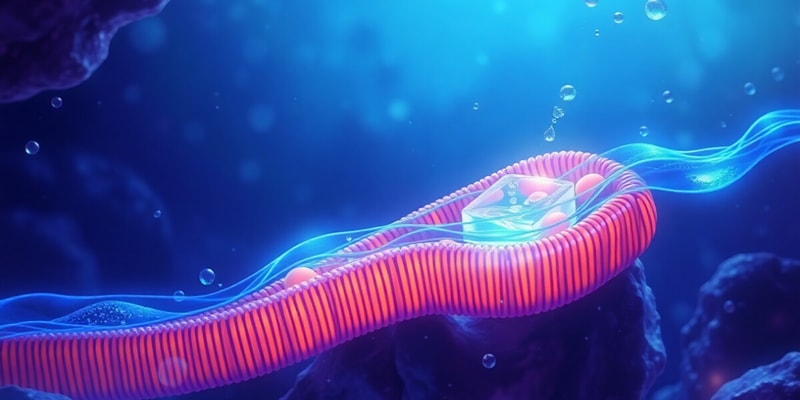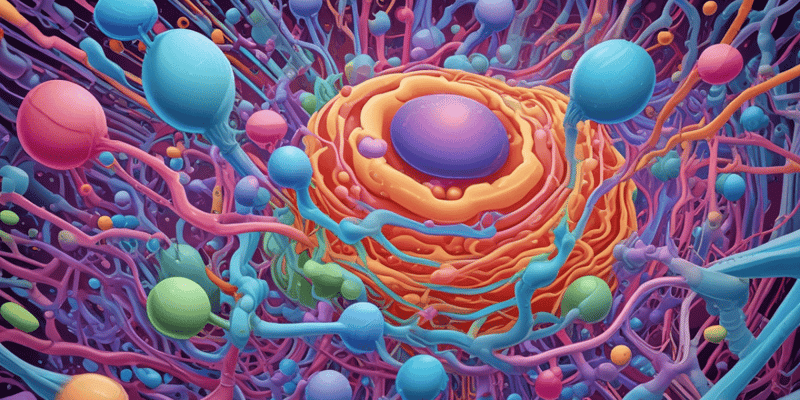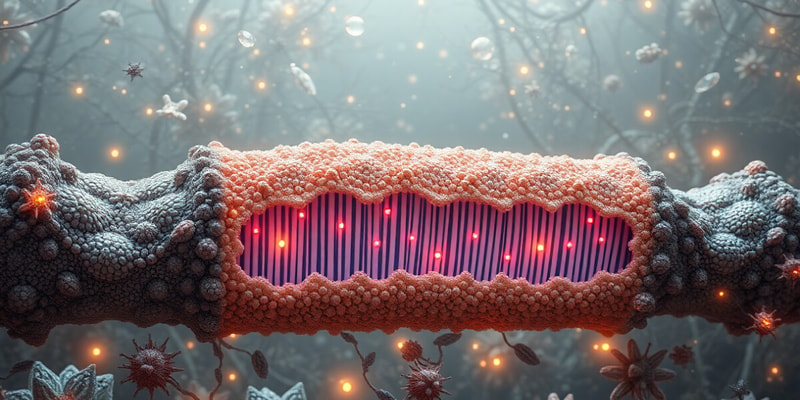Podcast
Questions and Answers
What is the primary function of the Na/Glu symporter in epithelial cells?
What is the primary function of the Na/Glu symporter in epithelial cells?
Why is oral rehydration therapy considered one of the biggest medical advances of the 20th century?
Why is oral rehydration therapy considered one of the biggest medical advances of the 20th century?
What role does the Na+ pump play in glucose and water uptake?
What role does the Na+ pump play in glucose and water uptake?
What happens to water during the process of glucose absorption in the intestine?
What happens to water during the process of glucose absorption in the intestine?
Signup and view all the answers
What is the consequence of the secretion of Cl- during sweating?
What is the consequence of the secretion of Cl- during sweating?
Signup and view all the answers
What primary role does the sodium pump have in intestinal glucose absorption?
What primary role does the sodium pump have in intestinal glucose absorption?
Signup and view all the answers
How does the Na/Glu symporter function in glucose transport?
How does the Na/Glu symporter function in glucose transport?
Signup and view all the answers
Where must the glucose uniporter be located to facilitate the movement of glucose into the interstitial space?
Where must the glucose uniporter be located to facilitate the movement of glucose into the interstitial space?
Signup and view all the answers
What type of transport mechanism is involved when glucose moves from epithelial cells to the interstitial space?
What type of transport mechanism is involved when glucose moves from epithelial cells to the interstitial space?
Signup and view all the answers
Why is the position of the sodium pump critical in intestinal absorption?
Why is the position of the sodium pump critical in intestinal absorption?
Signup and view all the answers
What is the primary energy source for the Na/Glu symporter?
What is the primary energy source for the Na/Glu symporter?
Signup and view all the answers
Which statement correctly describes the concentration of glucose in the intestinal lumen compared to epithelial cells?
Which statement correctly describes the concentration of glucose in the intestinal lumen compared to epithelial cells?
Signup and view all the answers
What transport mechanism do amino acids use for absorption in the intestine?
What transport mechanism do amino acids use for absorption in the intestine?
Signup and view all the answers
Which of the following best describes the relationship between sodium and glucose transport in epithelial cells?
Which of the following best describes the relationship between sodium and glucose transport in epithelial cells?
Signup and view all the answers
What role does the interstitial space play in glucose absorption?
What role does the interstitial space play in glucose absorption?
Signup and view all the answers
What is the role of the Na+/Glucose cotransporter in physiology?
What is the role of the Na+/Glucose cotransporter in physiology?
Signup and view all the answers
Which of the following best describes regulated water uptake as compared to bulk uptake?
Which of the following best describes regulated water uptake as compared to bulk uptake?
Signup and view all the answers
What major impact did the understanding of glucose absorption have in the 20th century?
What major impact did the understanding of glucose absorption have in the 20th century?
Signup and view all the answers
What is one of the foundations for understanding systems and integrated physiology?
What is one of the foundations for understanding systems and integrated physiology?
Signup and view all the answers
Which physiological process is demonstrated by the bulk uptake of water?
Which physiological process is demonstrated by the bulk uptake of water?
Signup and view all the answers
What aspect of physiology does studying glucose absorption help to illuminate?
What aspect of physiology does studying glucose absorption help to illuminate?
Signup and view all the answers
Which statement accurately reflects the role of bio-electric potentials in nerve physiology?
Which statement accurately reflects the role of bio-electric potentials in nerve physiology?
Signup and view all the answers
Which of the following systems is NOT one of the main 11 systems discussed in physiology?
Which of the following systems is NOT one of the main 11 systems discussed in physiology?
Signup and view all the answers
What process facilitates the movement of Na+ into cells initially?
What process facilitates the movement of Na+ into cells initially?
Signup and view all the answers
Which of the following correctly describes the role of the Na+/Glucose symporter?
Which of the following correctly describes the role of the Na+/Glucose symporter?
Signup and view all the answers
Why is the concentration of Na+ lower inside epithelial cells after the Na+ pump operates?
Why is the concentration of Na+ lower inside epithelial cells after the Na+ pump operates?
Signup and view all the answers
What is the main effect of the Na+ pump on the concentration gradient across the apical membrane?
What is the main effect of the Na+ pump on the concentration gradient across the apical membrane?
Signup and view all the answers
What type of junctions are primarily found between epithelial cells that assist in solute transport?
What type of junctions are primarily found between epithelial cells that assist in solute transport?
Signup and view all the answers
Which of the following correctly describes the transport of water in relation to Na+ movement?
Which of the following correctly describes the transport of water in relation to Na+ movement?
Signup and view all the answers
In the context of intestinal absorption, how does Na+ transport primarily influence glucose absorption?
In the context of intestinal absorption, how does Na+ transport primarily influence glucose absorption?
Signup and view all the answers
What cellular location is primarily responsible for extracting sodium ions from the intracellular fluid?
What cellular location is primarily responsible for extracting sodium ions from the intracellular fluid?
Signup and view all the answers
How does a leaky epithelial cell differ from a tight epithelial cell regarding solute transport?
How does a leaky epithelial cell differ from a tight epithelial cell regarding solute transport?
Signup and view all the answers
What is the ultimate purpose of having a Na+ concentration gradient across a cell membrane?
What is the ultimate purpose of having a Na+ concentration gradient across a cell membrane?
Signup and view all the answers
What is the primary mechanism of glucose absorption in the intestines?
What is the primary mechanism of glucose absorption in the intestines?
Signup and view all the answers
What distinguishes bulk uptake of water from regulated uptake?
What distinguishes bulk uptake of water from regulated uptake?
Signup and view all the answers
What role do tight junctions play in water absorption in the gut?
What role do tight junctions play in water absorption in the gut?
Signup and view all the answers
What factor is crucial for water absorption from the lumen to interstitial fluid?
What factor is crucial for water absorption from the lumen to interstitial fluid?
Signup and view all the answers
In healthy individuals, how is the process of water absorption characterized?
In healthy individuals, how is the process of water absorption characterized?
Signup and view all the answers
How does the body control the movement of water across cell membranes?
How does the body control the movement of water across cell membranes?
Signup and view all the answers
Which statement about bulk water absorption in the kidneys is true?
Which statement about bulk water absorption in the kidneys is true?
Signup and view all the answers
What is a significant characteristic of the tight junctions in the small intestine?
What is a significant characteristic of the tight junctions in the small intestine?
Signup and view all the answers
What is one of the major outcomes when an osmotic gradient is not maintained?
What is one of the major outcomes when an osmotic gradient is not maintained?
Signup and view all the answers
Why is the bulk uptake of water considered a constitutive process in healthy individuals?
Why is the bulk uptake of water considered a constitutive process in healthy individuals?
Signup and view all the answers
Study Notes
Transport Across Cell Membranes
- Glucose absorption is a critical physiological process.
- Na+/Glucose cotransporter is responsible for bulk glucose uptake.
- Sodium Pump: located on the basolateral membrane, it uses active transport to create a sodium concentration gradient.
- Na+/Glucose Symporter: located on the apical membrane, it uses the energy from sodium moving down its concentration gradient to drive glucose uptake.
- Glucose Uniporter: located on the basolateral membrane, it facilitates the movement of glucose from the cell to the interstitial space.
Water Absorption
- Bulk absorption of water in the intestines and kidneys is a key process.
- Tight Junctions: in the small intestine and proximal tubule of the kidney, they are 'leaky' and allow for water movement.
- Water absorption is driven by an osmotic gradient.
The Role of The Sodium Pump
- The sodium pump creates a low internal sodium concentration, enabling the Na+/Glucose symporter to function and draw glucose into the cell.
- This creates an osmotic gradient, allowing for the movement of water.
Oral Rehydration Therapy (ORT)
- ORT is a medical breakthrough that revolutionized the treatment of dehydration.
- It leverages the Na+/glucose co-transporter to efficiently rehydrate patients, specifically children.
- Key breakthrough: understanding the coupling of sodium and glucose transport in the small intestine.
Secretion of Water
- Sweating: an example of water secretion.
- Chloride ions are secreted, followed by water and sodium ions.
- This is why sweat is salty.
Studying That Suits You
Use AI to generate personalized quizzes and flashcards to suit your learning preferences.
Related Documents
Description
Test your knowledge on the mechanisms of transport across cell membranes, focusing on glucose and water absorption. Discover how the sodium pump and cotransporters function in physiological processes. This quiz will cover essential topics related to membrane transport in cells.




